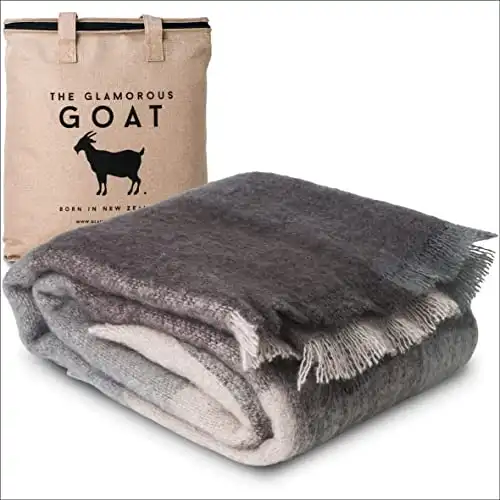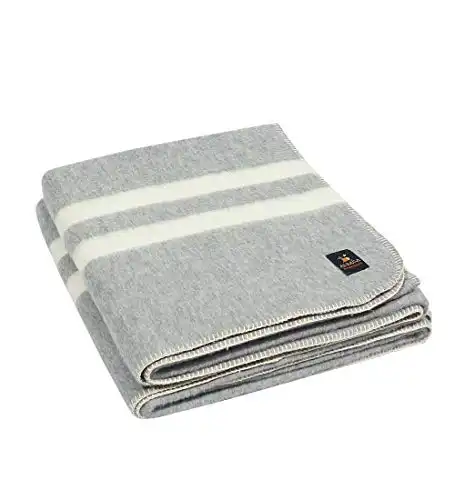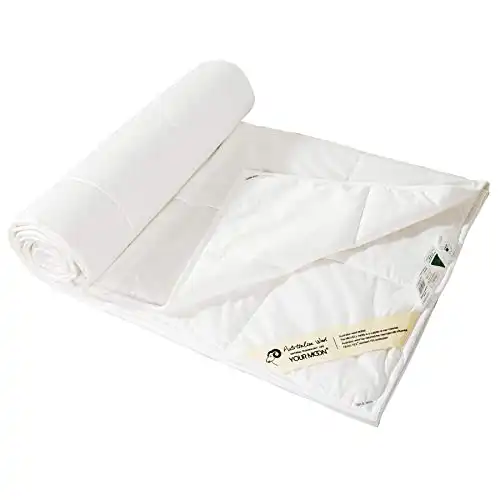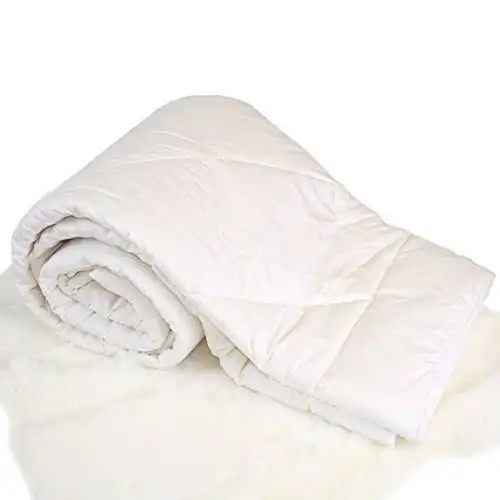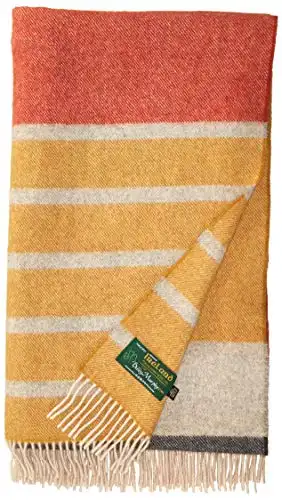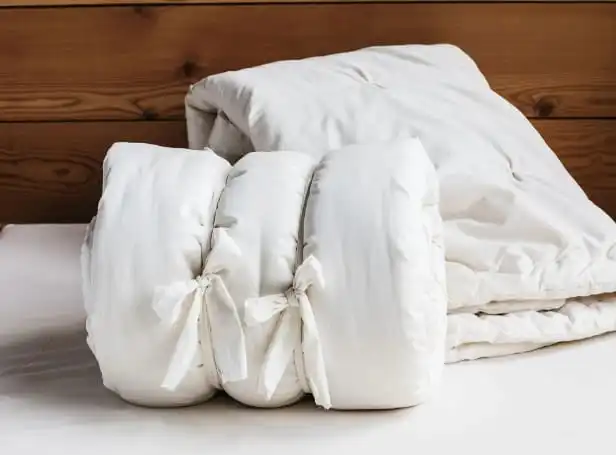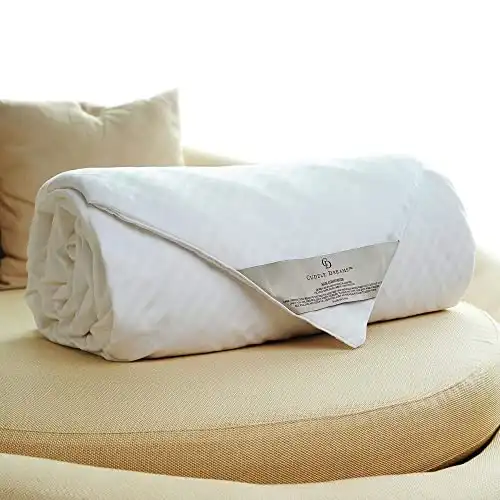- You are here:
- Home »
- Organic Bedding »
- Wool Blanket vs. Comforter: What’s the Difference?
As an Amazon Associate I earn from qualifying purchases.
Selecting the right bedding is a pivotal decision for achieving a good night’s sleep. In the realm of warmth and comfort, wool blankets and comforters are two stalwart contenders.
This comprehensive guide seeks to unravel the intricacies of wool blankets and comforters, comparing their characteristics, extolling their virtues, and assisting you in making an informed choice.
The Warmth Factor
When contemplating the warmth factor, both wool blankets and comforters shine, but their methods of achieving coziness differ significantly.
Wool Blankets:
- Natural Insulator: Wool stands out as a natural insulator, owing to its unique fibers that trap and retain heat. This inherent quality makes wool blankets an ideal choice for those seeking warmth without excessive weight.
- Breathability: Unlike synthetic materials, wool is exceptionally breathable. It wicks away moisture from the body, preventing overheating during warmer nights. This breathability creates a comfortable sleep environment, promoting restful sleep.
- Lightweight Comfort: Wool blankets provide the perfect balance of warmth and weight. Their lightweight nature is particularly appreciated by individuals who prefer a less cumbersome covering while enjoying a cozy night’s sleep.
|
$209.99
|
$174.99
|
N/A
|
Comforters:
- Fill Materials Matter: The warmth of a comforter is largely determined by its fill material. Down comforters, for instance, are renowned for their exceptional warmth-to-weight ratio, providing a luxurious and snug feel without excess bulk.
- Fluffy Insulation: The loftiness of comforter fill, whether down, synthetic, or a blend, creates air pockets that efficiently trap heat. This results in a fluffy and insulating layer that envelops you in warmth, mimicking the feeling of a comforting embrace.
- All-Season Options: Comforters are available in various weights, catering to individual preferences for warmth. From lightweight duvets suitable for warmer months to heavier comforters designed for colder seasons, there is a diverse array to accommodate every sleeper.
|
$85.99
|
$159.99
|
$207.00
|
Read More: Your Guide to Natural Comforter Fills
Maintenance and Care
Maintaining and caring for your bedding is paramount for its longevity and overall hygiene.
Wool Blankets:
- Natural Resistance: Wool possesses natural resistance to mold, mildew, and dust mites. This innate quality reduces the necessity for frequent washing, making wool blankets an excellent choice for those seeking low-maintenance bedding.
- Spot Cleaning: Regular maintenance is easily achieved through spot cleaning. Wool’s resistance to stains allows for simple and effective spot treatments, ensuring the longevity of the blanket.
- Hand Washable: While care instructions may vary by brand, most wool blankets can be hand-washed using a delicate wool detergent. This gentle method of cleaning helps preserve the delicate fibers and extends the life of the blanket.
Read More: Tips for Washing Wool Blankets
Comforters:
- Machine Washable: Many modern comforters are designed to be machine washable, providing a convenient solution for regular cleaning. Always check the care instructions to ensure proper maintenance.
- Dryer-Friendly: Drying comforters in a large-capacity dryer is recommended to maintain their loft and fluffiness. Proper drying ensures that the fill retains its insulating properties, keeping the comforter in peak condition.
- Attention to Fill: Different comforter fills may require specific care. Following the manufacturer’s recommendations for cleaning and maintenance is essential to preserve the integrity of the fill and ensure the longevity of the comforter.
Read More: Tips for Washing Wool Duvets
Style and Aesthetics
Beyond functionality, bedding plays a crucial role in the overall aesthetic of a bedroom.
Wool Blankets:
- Classic Appeal: Wool blankets exude a timeless, classic charm. Their natural texture and muted hues add an element of sophistication to any bedroom, creating a serene and inviting atmosphere.
- Versatility: Wool blankets come in a wide range of colors, patterns, and weaves, making them versatile for different bedroom aesthetics. Whether your style is rustic, modern, or traditional, there’s a wool blanket to complement your decor.
- Layering Possibilities: The thin, lightweight nature of wool blankets makes them perfect for layering. Whether draped over a comforter or folded at the foot of the bed, wool blankets offer a myriad of styling options to enhance the overall look of your bedding.
Comforters:
- Variety in Design: Comforters come in an extensive array of designs, from simple patterns to intricate quilting. This variety allows you to choose a comforter that aligns with your personal style and contributes to the overall aesthetic of your bedroom.
- Size Matters: Comforters are crafted to match standard bed sizes, ensuring a tailored and cohesive appearance when spread across the mattress. This attention to sizing contributes to a neat and put-together look in your bedroom.
- Coordinated Sets: For those seeking a seamless bedroom decor experience, many comforters are part of coordinated bedding sets. These sets often include matching shams, bedskirts, and decorative pillows, simplifying the task of creating a cohesive and stylish bedroom theme.
Read More: Best Organic Printed Sheets
Who Should Choose a Wool Blanket?
Wool blankets are an excellent choice for those who prioritize:
- Breathability: If you tend to sleep hot and need a breathable material that regulates temperature throughout the night.
- All-Season Use: Those seeking a versatile option that provides comfort in both warmer and cooler months due to wool’s natural insulating properties.
- Sustainability: Wool is a natural and renewable resource, making wool blankets an environmentally-friendly choice for bedding. It’s also a biodegradable material, reducing its impact on the environment at the end of its lifespan.
- Low Maintenance: If you prefer low-maintenance bedding that resists mold, mildew, and dust mites, reducing the need for frequent washing.
Read More: The Pros and Cons of Wool Blankets
Who Should Opt for a Comforter?
Comforters, on the other hand, are ideal for those who value:
- Luxurious Warmth: If you enjoy a plush and luxurious feel, particularly in colder climates, where the loftiness of a comforter provides exceptional warmth.
- Design Options: Those who appreciate a wide range of design choices and the ability to coordinate their bedding with the overall aesthetic of their bedroom.
- Different Fill Options: For individuals with specific preferences for fill materials, comforters provide a variety of options. If you live in a hot climate, a eucalyptus comforter may be more suitable, while wool duvet is ideal for cold weather.
- Convenience: People who prefer the convenience of machine-washable bedding and the ability to choose from different weights suitable for various seasons.
|
$167.99
|
$479
|
$62.99
|
$99.90
|
Tips for Shopping – Wool Blankets and Comforters
When shopping for the best wool blanket or comforter, consider these tips:
Buying Wool Blankets:
- Natural Materials: Opt for wool blankets made from 100% natural wool for the best performance. Look for labels indicating merino or lambswool for enhanced softness. Woolmark certified products ensure quality and traceability of the wool used.
- Organic Certification: Whenever possible, choose organic wool blankets with organic certifications, such as GOTS (Global Organic Textile Standard), ensuring the product meets stringent environmental and social criteria.
- Weave and Weight: Consider the weave and weight of the wool blanket. A tightly woven blanket with a medium weight is often a versatile choice for various climates.
Buying Comforters:
- Natural Fill: Choose comforters with natural fills like down or wool for a breathable and environmentally friendly option. Check for certifications, such as the Responsible Down Standard (RDS) for down-filled comforters.
- GOTS Certified Organic Cotton Cover: Ensure that the comforter’s outer shell is made from organic cotton, certified by GOTS. This certification guarantees the use of sustainable and environmentally friendly practices in the production process.
- Fill Power: For down comforters, look for fill power ratings. The higher fill power indicates better insulation, providing a warmer and fluffier feel without excess weight.
- Stitching: Consider the stitching pattern, which affects the overall look and durability of the comforter. Baffle box stitching is generally preferred for down comforters as it prevents fill from shifting and creating lumps. Quilted or channel stitching can be suitable for wool-filled comforters.
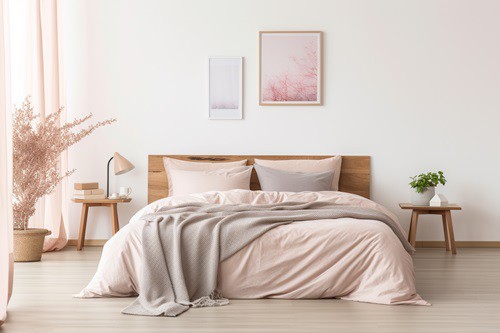
Conclusion
When it comes to deciding between a wool blanket and comforter, the decision ultimately hinges on individual preferences, lifestyle, and the desired aesthetic for your sleep sanctuary. Whether you’re drawn to the natural elegance of wool or the plush embrace of a comforter, both options guarantee a warm and restful night’s sleep.
Understanding the nuances of each allows you to make an informed choice that aligns with your unique preferences and contributes to the overall coziness and style of your bedroom.
Additionally, prioritizing natural materials and certifications like GOTS ensures not only your comfort but also a commitment to sustainability and environmental responsibility in your bedding choices.
About the Author Kamila Flieger
My name is Kamila, and I'm passionate about researching non-toxic, organic products for the home. I believe it's so important to create a safe and healthy environment for our families, and I enjoy helping others do the same.

